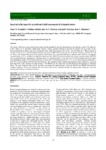Use este identificador para citar ou linkar para este item:
http://www.alice.cnptia.embrapa.br/alice/handle/doc/1041649Registro completo de metadados
| Campo DC | Valor | Idioma |
|---|---|---|
| dc.contributor.author | BRANDAO, Z. N. | pt_BR |
| dc.contributor.author | SOFIATTI, V. | pt_BR |
| dc.contributor.author | BEZERRA, J. R. C. | pt_BR |
| dc.contributor.author | FERREIRA, G. B. | pt_BR |
| dc.contributor.author | MEDEIROS, J. C. | pt_BR |
| dc.date.accessioned | 2016-03-22T11:11:11Z | pt_BR |
| dc.date.available | 2016-03-22T11:11:11Z | pt_BR |
| dc.date.created | 2016-03-22 | pt_BR |
| dc.date.issued | 2015 | pt_BR |
| dc.identifier.citation | Australian Journal of Crop Science, v. 9, n. 1, p. 75-84, jan. 2015. | pt_BR |
| dc.identifier.issn | 1835-2693 | pt_BR |
| dc.identifier.uri | http://www.alice.cnptia.embrapa.br/alice/handle/doc/1041649 | pt_BR |
| dc.description | The canopy reflectance using ground-based sensors has the potential to provide information on crop nitrogen content. The objective of this study was to determine relationships between canopy spectral reflectance and leaf N content, leaf area index (LAI), aboveground biomass (Biom) and yield of irrigated cotton under four nitrogen rates (0, 90, 180 and 270kg ha-1). Measurements of canopy reflectance were made throughout the growing seasons (2009-2010) using a hand-held spectroradiometer. Samples for LAI and Biom were obtained three times from squaring until fruiting. The normalized difference vegetation index (NDVI), soil adjusted vegetation index (SAVI), modified soil adjusted vegetation index (MSAVI) and the modified transformed vegetation index (MTVI2) were calculated from the hyperspectral reflectance data. All vegetation indexes (VIs) and also SPAD-502 readings allowed to figure out mathematical models for N content prediction in cotton leaves with great precision (r > 0.74). It also showed good correlations (r from 0.55 to 0.96) with the LAI since the first flowering. The vegetation indexes obtained through the canopy reflectance, explained more than 64% of the variation in cotton biomass. The MTVI2 was the index that provided the best LAI prediction in advanced stages. The peak flowering stage was the best time to estimate the cotton biomass, where the MSAVI and MTVI2 showed to be excellent predictors. The results indicate that the cotton yield can be estimated through the hyperspectral reflectance since the squaring until fruiting in irrigated conditions. | pt_BR |
| dc.language.iso | por | pt_BR |
| dc.rights | openAccess | pt_BR |
| dc.subject | Irrigated cotton | pt_BR |
| dc.subject | Nitrogen fertilization | pt_BR |
| dc.title | Spectral reflectance for growth and yield assessment of irrigated cotton. | pt_BR |
| dc.type | Artigo de periódico | pt_BR |
| dc.date.updated | 2016-03-22T11:11:11Z | pt_BR |
| dc.subject.thesagro | Gossypium hirsutum | pt_BR |
| dc.subject.thesagro | Algodão | pt_BR |
| dc.subject.thesagro | Área foliar | pt_BR |
| dc.subject.nalthesaurus | leaf area index | pt_BR |
| dc.subject.nalthesaurus | remote sensing | pt_BR |
| riaa.ainfo.id | 1041649 | pt_BR |
| riaa.ainfo.lastupdate | 2016-03-22 | pt_BR |
| dc.contributor.institution | ZIANY NEIVA BRANDAO, CNPA; VALDINEI SOFIATTI, CNPA; JOSE RENATO CORTEZ BEZERRA, CNPA; GILVAN BARBOSA FERREIRA, CNPA; JOSÉ C. MEDEIROS, CNPA. | pt_BR |
| Aparece nas coleções: | Artigo em periódico indexado (CNPA)  | |
Arquivos associados a este item:
| Arquivo | Descrição | Tamanho | Formato | |
|---|---|---|---|---|
| Spectralreflectanceforgrowth....pdf | 798.16 kB | Adobe PDF |  Visualizar/Abrir |









